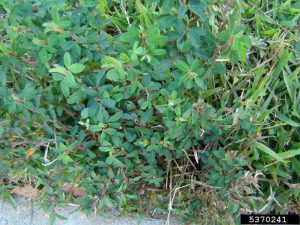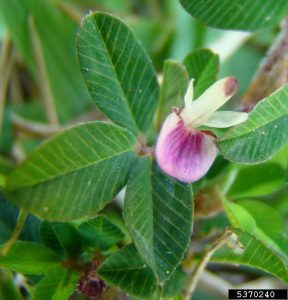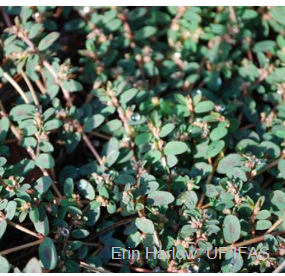“There are these weeds spreading all over my yard. They have little round leaves that are real close to the ground and creep in every direction. I keep trying to get rid of them by mowing my grass shorter, but they are killing my grass. What are they and how do I get rid of them?” Here at the Extension office, this is a conversation I have had nearly daily for the past month. We are here to help with identification and control of many landscape problems, including weeds.
However, my first word of advice is to change the mowing practice. Short, spreading weeds cannot be mowed out. You need to do just the opposite. Mowing as high as possible (3-4”) will help to reduce weeds by shading them out, therefore, reducing their spread.
In every instance, the weeds have been common lespedeza (Kummerowia striata (Thunb.) Schind syn. Lespedeza striata) and/or prostrate spurge (Euphorbia maculata syn. Chamaesyce maculata). Both grow close to the ground with a spreading habit. Both have small, rounded leaves and produce small, light-colored flowers. But, if you look close, there are significant differences that will help with identification.
 Common lespedeza, also known as Japanese clover, is prostrate summer annual that forms 15-18 inch patches. The stems are wiry. It has dark green trifoliate
Common lespedeza, also known as Japanese clover, is prostrate summer annual that forms 15-18 inch patches. The stems are wiry. It has dark green trifoliate  (arranged in threes) leaves with three oblong, smooth leaflets. Leaflets have parallel veins nearly at right angles to a prominent mid-vein. Its leaves have smooth edges and a short spur at the tip of each leaflet. Flowers appear in late summer with small pink to purple, single flowers found in leaf axils on most of the nodes of the main stems. As common lespedeza matures, the stems harden and become woody.
(arranged in threes) leaves with three oblong, smooth leaflets. Leaflets have parallel veins nearly at right angles to a prominent mid-vein. Its leaves have smooth edges and a short spur at the tip of each leaflet. Flowers appear in late summer with small pink to purple, single flowers found in leaf axils on most of the nodes of the main stems. As common lespedeza matures, the stems harden and become woody.
Prostrate spurge is a summer annual broadleaf weed that spreads by seed. The leaves are oval in shape, small, and opposite along the stem. As it matures, a red spot may form in the center of the leaf, earning it the common name spotted spurge. Another distinct characteristic is the stem contains a milky sap that oozes when the stem is broken. Light pink to white-colored flowers appear from early-summer through the fall.
Both are annual,broadleaf weeds, so there are several post-emergent herbicides available to kill the ones present. Don’t forget the pre-emergent herbicide application in late winter though. These weeds can drop plenty of seed. The importance of knowing which weed you have is more about the message they are trying to send you. These weeds can indicate other issues that may be part of the reason the grass is thinning and allowing the weeds to take over in the first place.
Common lespedeza is a legume. It thrives when water is plentiful and soil nutrients are low. If this is the weed “taking over” your yard, you need to get a soil test and evaluate your watering habits. Improving fertility and reducing soil moisture will naturally weaken common lespedeza.
If your thin patches of declining grass are being replaced with spurge, it may be time to submit a sample for a nematode assay. Research has shown that spurge is a weed that can thrive with high populations of nematodes. Turfgrass species are easily harmed by nematodes (microscopic roundworms that imbed into and on grass roots). If the assay indicates harmful population levels, unfortunately there are few options for reduction of the nematodes. However, several ornamental plants are tolerant. So, you may need to consider creating a landscape bed area rather than continuing to battle poor-looking grass.
Weeds can serve as indicators to soil conditions that may need to be addressed. Learning to identify weeds may teach you more than just their names.
- Watch for “Melting Grass” - February 19, 2025
- Palms Can Suffer in the Cold - January 30, 2025
- Camellia Care - January 9, 2025
